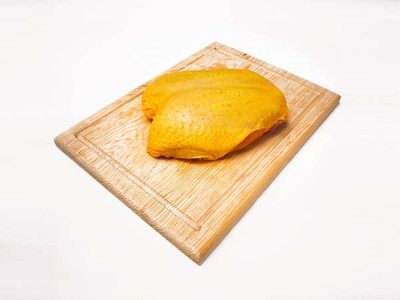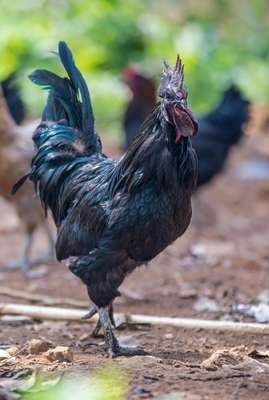Is Your Costco Chicken Yellow? What You Need to Know Before Your Next Meal!
By
Veronica E.
- Replies 0
When you're walking through the aisles of Costco, cart in hand, ready to stock up on your favorite essentials, you might not expect a puzzling question to pop up in the meat section. But there it is—a chicken with a golden hue that seems to stand out from the usual pinkish-white color.
If you've ever paused and wondered, "Is this chicken safe to eat?" you’re not alone. Here’s what you need to know to put your concerns to rest!
Believe it or not, the color of raw chicken isn’t just about appearances—it’s tied to biology, diet, and even farming practices.
According to the United States Department of Agriculture (USDA), raw poultry can naturally range in color from bluish-white to yellow, and all of these shades are perfectly normal for healthy chicken.

A diet rich in marigold petals is one common factor that can give chicken flesh a yellowish tint. These flowers, widely known for their bright, cheerful color, are packed with antioxidants that also enhance the hue of the meat.
Interestingly, this diet also affects egg yolks. Chickens fed marigolds lay eggs with yolks that are vibrantly orange—a sign of richness that many chefs and home cooks prize.
While we’re talking about chicken colors, let’s explore the striking Ayam Cemani, a rare breed from Indonesia. This bird is entirely black—from its feathers to its flesh—thanks to a genetic condition called fibromelanosis.
While stunning to look at, this luxury chicken is far from your typical Costco purchase. Instead, it’s a collector’s dream and a symbol of nature’s incredible variety.

However, safety and quality are still the most important factors when choosing poultry. Keep these tips in mind while shopping:
Using a meat thermometer can help you avoid undercooking or overcooking, so your meal is both safe and delicious.

Have you ever brought home a yellow chicken from Costco and wondered about its vibrant color? Or perhaps you have a favorite recipe that makes any chicken shine, regardless of its hue. We’d love to hear your experiences and cooking tips—share them in the comments below!
If you've ever paused and wondered, "Is this chicken safe to eat?" you’re not alone. Here’s what you need to know to put your concerns to rest!
Believe it or not, the color of raw chicken isn’t just about appearances—it’s tied to biology, diet, and even farming practices.
According to the United States Department of Agriculture (USDA), raw poultry can naturally range in color from bluish-white to yellow, and all of these shades are perfectly normal for healthy chicken.

Costco chicken's yellow hue is simply due to its diet and is completely safe to eat! Image Source: Pexels / Miguel Guerra.
Why Does Some Chicken Look Yellow?
The golden glow on some chicken meat is not a cause for alarm. In fact, it often comes down to what the chickens eat.A diet rich in marigold petals is one common factor that can give chicken flesh a yellowish tint. These flowers, widely known for their bright, cheerful color, are packed with antioxidants that also enhance the hue of the meat.
Interestingly, this diet also affects egg yolks. Chickens fed marigolds lay eggs with yolks that are vibrantly orange—a sign of richness that many chefs and home cooks prize.
The Most Expensive Chicken Is Black, Not Yellow!
While we’re talking about chicken colors, let’s explore the striking Ayam Cemani, a rare breed from Indonesia. This bird is entirely black—from its feathers to its flesh—thanks to a genetic condition called fibromelanosis.
While stunning to look at, this luxury chicken is far from your typical Costco purchase. Instead, it’s a collector’s dream and a symbol of nature’s incredible variety.

Meet the Ayam Cemani, a rare and striking chicken breed known for its all-black feathers, skin, and even meat! Image Source: Pexels / Anil Sharma
What You Should Look for When Buying Chicken
Now that you know yellow chicken isn’t a sign of trouble, you can feel confident about adding it to your cart.However, safety and quality are still the most important factors when choosing poultry. Keep these tips in mind while shopping:
- Freshness: Always check the sell-by date.
- Temperature: The chicken should feel cold to the touch.
- Packaging: Look for intact packaging with no tears or leaks.
- Smell: Fresh chicken should have little to no odor.
Cooking Chicken Safely
Once you’ve picked out your chicken, proper cooking is key. The USDA recommends cooking chicken to an internal temperature of 165°F (approximately 74°C) to ensure it’s safe to eat.Using a meat thermometer can help you avoid undercooking or overcooking, so your meal is both safe and delicious.
Key Takeaways
- Raw chicken meat can vary in color from bluish-white to yellow, and this is normal according to the USDA.
- Factors such as the chicken’s age, breed, diet, and exercise influence the color of its flesh.
- The yellow tint in chicken flesh can be due to the chicken's diet containing marigolds, which also affect the color of the yolk.
- The Ayam Cemani breed has jet-black skin and flesh, but this is a rare exception and not typically found in supermarkets like Costco.
Have you ever brought home a yellow chicken from Costco and wondered about its vibrant color? Or perhaps you have a favorite recipe that makes any chicken shine, regardless of its hue. We’d love to hear your experiences and cooking tips—share them in the comments below!






